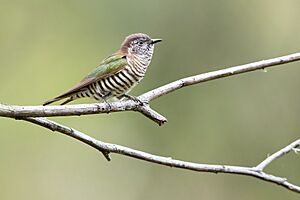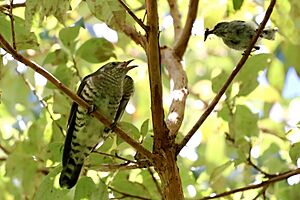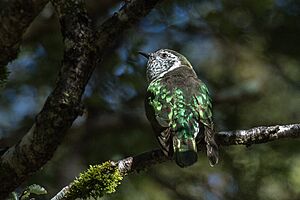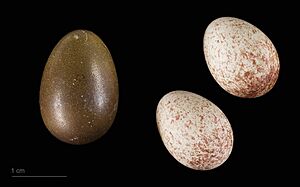Shining bronze cuckoo facts for kids
Quick facts for kids Shining bronze cuckoo |
|
|---|---|
 |
|
| In NSW, Australia | |
| Conservation status | |
| Scientific classification | |
| Synonyms | |
|
Chalcites lucidus |
The shining bronze cuckoo (Chrysococcyx lucidus) is a small bird. It lives in places like Australia, New Zealand, and many islands in the Pacific Ocean. It is a type of cuckoo bird.
This cuckoo is quite small, only about 13 to 18 centimeters long. It is famous for being a 'brood parasite'. This means the mother cuckoo lays her eggs in the nests of other birds. She often chooses dome-shaped nests of birds like the Gerygone species. The shining bronze cuckoo is the most southerly living brood parasitic bird in the world.
Contents
What is a Shining Bronze Cuckoo?
The shining bronze cuckoo is hard to spot, but easier to hear. It is about 13 to 18 centimeters long. Its wings can spread out about 25 to 32 centimeters wide. This bird weighs around 25 grams.
It has shiny, metallic golden or coppery green feathers on its back. Its cheeks and belly are white with dark green stripes. Female cuckoos look similar, but their heads might have a purplish shine. Their bellies have more bronze-colored stripes. The cuckoo's beak is black, and its feet are black with yellow undersides.
Where Do Shining Bronze Cuckoos Live?
Shining bronze cuckoos are summer visitors to eastern and western Australia. They fly to places like the Lesser Sunda Islands and New Guinea for winter.
Birds from New Zealand spend their winter in the Solomon Islands. They start arriving in New Zealand in mid-August. They can be found across New Zealand, even high up in the mountains. Some groups of cuckoos that live on islands like New Caledonia and Vanuatu do not migrate. They stay in the same place all year.
Life Cycle and Reproduction

When a female shining bronze cuckoo is ready to lay an egg, she finds another bird's nest. She lays one egg in the nest and removes one of the host bird's eggs. After the baby cuckoo hatches, it pushes the other baby birds out of the nest. This way, it gets all the food and attention from the host parents.
In New Zealand, the grey warbler is a common host bird. Shining bronze cuckoos often lay eggs in their nests. Studies have shown that about 55% of grey warbler nests in one area had cuckoo eggs. The cuckoo's eggs are often dark. This helps them blend in with the shadows of the warbler's nest. This makes it harder for other cuckoos to spot them and lay another egg in the same nest.
The Chatham gerygone is another host bird in the Chatham Islands. The cuckoo eggs are usually olive brown or dark brown. They do not look like the eggs of the host birds.
Sometimes, other bird species also become hosts. In Australia, a pair of chestnut-rumped heathwrens were seen feeding a young shining bronze cuckoo. Even introduced birds like the house sparrow and song thrush have been hosts in New Zealand.
In New Caledonia, the fan-tailed gerygone is the only bird that hosts the shining bronze cuckoo.
What Do Shining Bronze Cuckoos Eat?
Shining bronze cuckoos mainly eat insects. They can eat insects that other birds avoid. This includes caterpillars, especially those of the magpie moth. They also eat beetles, like ladybirds. The cuckoo has a special stomach lining that catches caterpillar spines. The bird can then spit these spines out.
Threats to Shining Bronze Cuckoos
Sometimes, shining bronze cuckoos can be caught by cats. They have also been known to die after flying into windows.
Images for kids






